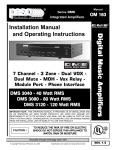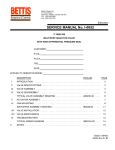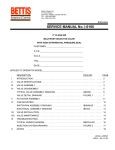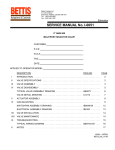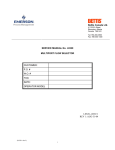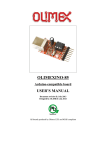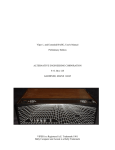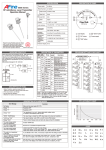Download Emerson I-0168 Service Manual
Transcript
Bettis Canada Ltd. 4112 91A Street Edmonton, Alberta, Canada T6E 5V2 Tel: (403) 450-3600 Fax: (403) 450-1400 Edmonton SERVICE MANUAL No. I-0168 MULTIPORT ELECTRONIC CONTROLLER CUSTOMER: P.O.#: W.O.#: TAG: DATE: APPLIES TO OPERATOR MODEL: DESCRIPTION DWG.NO. PAGE I INTRODUCTION . . . . . . . . . . . . . . . . . . . . . . . . . . . . . . . . . . . . . . . . . . . . . . . . . . . . . . . . . 2 II ACTUATOR ASSEMBLY . . . . . . . . . . . . . . . . . . . . . . . . . . . . . . . . . . . . . . . . . . . . . . . . . . . 2 TYPICAL ELECTRICAL ASSEMBLY DRAWING . . . . . . . . . . . . . . . . . . IB0165 . . . . . . . . 4 MULTIPORT ELECTRONIC CONTROLLER . . . . . . . . . . . . . . . . . . . . . . . . . . . . . . . . . . . . 5 ASSEMBLY DRAWING . . . . . . . . . . . . . . . . . . . . . . . . . . . . . . . . . . . . CB0175 . . . . . . . 15 TYPICAL WIRING DIAGRAM, DC SUPPLY . . . . . . . . . . . . . . . . . . . . . SB0708-X00 . . . . 16 TYPICAL WIRING DIAGRAM, AC SUPPLY . . . . . . . . . . . . . . . . . . . . . SB0708-X01 . . . . 17 TYPICAL BOARD DIAGRAM . . . . . . . . . . . . . . . . . . . . . . . . . . . . . . . . . APB1359-## . . . . 18 IV TROUBLESHOOTING . . . . . . . . . . . . . . . . . . . . . . . . . . . . . . . . . . . . . . . . . . . . . . . . . . . . . 19 V NOTES . . . . . . . . . . . . . . . . . . . . . . . . . . . . . . . . . . . . . . . . . . . . . . . . . . . . . . . . . . . . . . . . 20 III I-0168--.WPD REV 2: DEC-15-97 I INTRODUCTION The Multiport Electronic Controller (MEC) replaces the SW28 Switchpak, for the Multiport Selector Valve. This service manual is intended to supersede the SW28 Switchpak information in Multiport Selector Valve service manuals. II ACTUATOR ASSEMBLY A. MULTIPORT ELECTRONIC CONTROLLER (MEC): SWITCHPAK PEDESTAL, CONNECTOR, SWITCHPAK MODEL SW20N-AM AND ELECTRICAL CONDUIT (OPTIONAL LOCAL CONTROL STATION AND DIGITAL DISPLAY) NOTE : For MEC, see the typical actuator assembly drawing on page 4. 1. Install Switchpak pedestal (449) in place and install the six studs (452), washers (453) and nuts (454). 2. Start threading the setscrew in the Switchpak connector (457) and place on the speed reducer shaft. Set coupling (455) on top of Switchpak connector. 3. Install adapter (459) on the Switchpak (300) shaft with setscrew (465). Set the Switchpak SW20N-M in place onto the coupling (455) and install the four bolts (458), flatwashers (461), and lockwashers (462). 4. Install electrical conduit for the MEC as follows: a) Standard connections for Switchpak SW20N-AM and motor: Off the Switchpak, assemble 1 NPT x 3/4 NPT reducer (322), 3/4 NPT close nipple (310), seal enclosure (315), seal cover (314), 3/4 NPT x 2.75 long nipple (313), field power supply connection enclosure (334), 3/4 NPT x 2.75 long nipple (313), 3/4 NPT capped elbow (321), 3/4 NPT x 3.50 long nipple (312), and the 3/4 NPT union (320) to the motor terminal box. Install 3/4 NPT plugs for the enclosures and 1/2 NPT plug for the seal cover. b) Optional connections for local control station: Off the Switchpak pedestal, assemble the local control station (350), STEP/JOG pushbutton (356), REMOTE/JOG/STEP 3-position switch (357), 3/4 NPT x 3 long nipple (318), 3/4 NPT capped elbow (321), 3/4 NPT x 2.50 long nipple (317). Thread into the seal enclosure (315) until the back of the control station is flush with the Switchpak pedestal. Loosely install bolt (351), flatwashers (353), lockwashers (354), and nut (352). Use spacer (358) if required. Install 3/4 NPT plug for the control station. c) Optional connections for digital display: Off the Switchpak pedestal, loosely install the display bracket (506) with bolts (516), lockwashers (520), flatwashers (522), and nuts (518). Connect digital display enclosure (500) to seal enclosure (315) with 3/4 NPT x 2 long nipple. Loosely attach display enclosure to bracket with bolts (508), lockwashers (512), flatwashers (514) and nuts (510). Install positional display board assembly (502) to enclosure (500) with standoff (504) and screws (505). 2 ACTUATOR ASSEMBLY continued . . . 5. See the typical drawing for Switchpak SW20N assembly on page 15, and the typical wiring diagrams on page 16 for DC supply and page 17 for AC supply. Install all wiring according to the electrical diagram and local regulations. 6. Check shaft alignment of the electronic controller to speed reducer by rotating both shafts independently, without binding occurring in the connector. Adjust if necessary. 7. With the Switchpak, the optional local control station and/or the digital display aligned on the Switchpak pedestal, tighten all mounting bolts, nuts and setscrews. 8. Pour seal enclosure (315), or tag. 9. Tag power supply connection wires in enclosure (334), install plug (303) and tag as power supply field connection point. 10. Install entry plugs (301, 302, 309) in the Switchpak SW20N enclosure (300) and tag as communication field connection point. 3 III MULTIPORT ELECTRONIC CONTROLLER A. INTRODUCTION The Bettis Multiport Electronic Controller (MEC) consists of a motor, Switchpak model SW20N, optional local control station and position display. It is a microcontroller based system developed to control and monitor status of the Multiport Selector Valve. It provides improved accuracy, eliminates mechanical adjustment of cams, and allows digital communication with one or more Multiport Valves over a single cable. B. TECHNICAL DESCRIPTION The MEC uses an optical absolute encoder to read the position of the valve into a 8 bit microcontroller. The encoder resolution is 1024 readable positions within the 360b rotation of the valve which results in the plug position being monitored to 0.35b accuracy. The microcontroller controls the motor on/off relay, and the optional digital display, with input from an external host device (computer, RTU or PLC) via a digital communication connection. The inputs from the optional local control station (switch position and pushbutton sense) are also connected to the microcontroller. The microcontroller utilizes a memory chip (EEPROM) which retains the home port setting, and ASCII text message for the valve, even during power failure. C. ELECTRONIC CONTROLLER SPECIFICATIONS INPUT VOLTAGE OPTIONS: 1. 120 VAC (50 - 60 Hz) USES SOLID STATE AC RELAY AND TRANSFORMER 2. 24 VDC USES SOLID STATE DC RELAY AND TRANSFORMER IF REQUIRED BOARD INPUT VOLTAGE: 8 - 30 VDC OR 9 - 20 VAC BOARD INPUT CURRENT: 0.5 AMP MAXIMUM BOARD (MP-08): CONFORMAL COATED LIGHTING PROTECTED FUSE: 1 AMP TIME DELAY TEMPERATURE RATING: -40bC TO +70bC -40bC TO +85bC OPTIONALLY SHOCK AND VIBRATION: 10 G's HUMIDITY: 98% WITHOUT CONDENSATION PROTOCOLS: 1. ASCII BASED CPU CHIP LABELLED "STD" 2. MODBUS RTU CPU CHIP LABELLED "MODBUS" 5 MULTIPORT ELECTRONIC CONTROLLER continued... D. COMMUNICATIONS 1. ASCII BASED PROTOCOL/RS-232 CONNECTION The standard communications protocol for the MEC uses a simple ASCII format which connects the host device (computer, RTU or PLC) through jumper selectable connection. Refer to board drawing on page 18 for the jumper location, jumper ‘A’ for RS-232. The external host device sends commands through a RS-232 cable to the electronic controller at 1200 baud with 8 bits, no parity and one stop bit. The following is a list of commands and responses. The CPU chip is labelled "STD". NOTE: In the following table the '<cr>' is the ASCII character #13 (0x0d). ?<cr> Request status apo<cr> Response where: a= p= o= !p<cr> t<cr> position '1' to '8' Response where: a= $pt<cr> 'O' for 'on' position, or 'F' for 'off' position Go to position where: p= a<cr> 'R' for REMOTE selector setting, or 'J' for JOG selector setting, or 'S' for STEP selector setting position '1' to '8' 'R' for REMOTE selector setting, or 'J' for JOG selector setting, or 'S' for STEP selector setting Write valve position message where: p= position '1' to '8' t= text message up to 16 characters #<cr> Request status using 'text' response t<cr> Response where: t= text message for position of valve @<cr> Request list of disabled positions dddddddd<cr> Response where: d= number of active position '1' to '8' (if a position is disabled, a '-' will be in that *h<cr> Set the Home position a<cr> Response where: a= 'R' for REMOTE selector setting, or 'J' for JOG selector setting, or 'S' for STEP selector setting Optional software is available for personal computers in DOS, Windows 3.11, or Windows 95 versions. 6 MULTIPORT ELECTRONIC CONTROLLER continued... 2. MODBUS RTU PROTOCOL/RS-485 CONNECTION • • • • • • • • • • • Modbus RTU mode communications Supports unit address 1 to 250 Two wire RS-485 or five wire RS-232 operation Allows 32 MECs network on a communication line 9600 baud, 8 data bits, 1 stop bit, no parity Uses 120 OHMS 24 AWG twisted pair shielded cable Cable example: Belden #9841 Multidrop configuration 4000 feet maximum cable length 120 OHMS termination resistor required at the furthest point Control board (MP-08) interface uses Linear Technology LTC-485 I.C. - 70 mV Hysteresis - -7 Volts to 12 Volts Common Mode Range - Auto thermo shutdown in case of cable short - Set address ports as required, and jumper 'B' for RS-485. Refer to board drawing on page 18 for these jumper locations. RS-485 network diagram HOST DEVICE (COMPUTER/PLC) RS-485 120 OHM TWISTED PAIR SHIELDED CABLE BETTIS MEC ADDRESS PORT 1 BETTIS MEC ADDRESS PORT 2 120 OHM TERMINATING RESISTOR UP TO 32 TOTAL BETTIS MEC Modbus register definitions Function 3 Function 6 Read data from register Write data to register Register 40001 Write to set Position. - Setting bits 1 to 8 in this register will move the valve to required position. - The bit will be cleared when the position is made. - If controller is not in REMOTE mode, the motor will not start and the bit will be cleared. - Setting bit 16 while the motor is running will stop the motor immediately. Register 40002 Read current position and status. - Bits 1 to 8 will indicate the position the valve is near (1 = Near or On Position.) - Bit 9 set in JOG mode. - Bit 10 set in STEP mode. - Bit 11 set in REMOTE mode. - Bit 12 indicates motor running. - Bit 13 indicates motor running but no movement (equipment failure.) - Bit 14 set indicates motor running but cannot find exact valve location (equipment failure). - Bit 16 set will indicate that the valve is exactly on position with bit 1 to 8 indicating position. If bit 16 is not set the valve is near a position. 7 MULTIPORT ELECTRONIC CONTROLLER continued... Register 40003 Read disable positions. - Bits 1 to 8 indidacte which positions are disabled. Register 40004 Read current encoder position. - 0 to 1023 Register 40005 Write to set home position number. Read current home position number. - 1 to 8 RS-232 connections to MP-08 DA-09 connector: Pin #2 = RX-232 TX to host Pin #3 = RS-232 RX from host Pin #5 = Signal ground Pin #7 = RTS to host Pin #8 = CTS from host RS-485 connections to MP-08 DA-09 connector: Pin #6 = RS-485 Pin #9 = RS-485 + General RS-485 cable specifications are: - 1 pair twisted shielded - 120 ohm impedance - 30 Volt rating - 24 gauge - stranded conductors Example: Belden #9841 with RS-485, maximum distance is 4000 ft. When using other cable, the terminating resistance may vary from 120 OHM. Contact the factory for assistance. Optional software is available for personal computers in DOS, Windows 3.11, and Windows 95 versions. E. ELECTRONIC CONTROLLER FEATURES When a command is sent from the host device to move the valve to a position, the MEC turns on the motor and monitors the position until the valve is within a few degrees of actual position. At that time the motor will be turned off to prevent its momentum from overshooting the required position. If the valve is still not quite on position, the microcontroller will pulse the motor to slowly move to the exact position. The microcontroller will also compensate for changes in torque requirements to accurately position the valve, regardless of the media or valve conditions. Small pushbuttons on the circuit board allow local control for calibration/maintenance purposes. Jumpers on the circuit board will disable any ports on the Multiport Valve which are not being utilized. LED's on the circuit board indicate operating status. 8 MULTIPORT ELECTRONIC CONTROLLER continued... F. OPTIONS 1. The optional digital display will indicate the valve position by port numbers 1 to 8. The corresponding port number will flash on the display when the valve plug is moving near or passing by a port, whether by using local controls or remote commands. Once the movement has stopped, the display will flash the port number that the valve is nearest, or a solid port number if the valve is exactly on position. The decimal point on the LED display will flash to indicate that all functions of the MEC are operating normally. 2. The optional local control station contains a 3-position selector switch and a STEP/JOG pushbutton. The three selector modes are REMOTE (this enables communication with the host device and disables the pushbutton), JOG (this runs the motor and moves the valve while the pushbutton is pressed) and STEP (this advances the valve plug to the next port after the pushbutton is momentarily pressed). 3. Software for personal computers in DOS, Windows 3.11, Windows 95 versions provide a graphical representation of MEC operation. G. OPERATION For MEC without the local control station, the Multiport Selector Valve can be controlled by the small buttons on the circuit board, or by remote commands received through the communication port. The control buttons marked on the circuit board are the "SET ZERO" button for calibrating home port position, the "HOME" button for returning the valve to home port position automatically (after momentary contact, the MEC takes over), and the "JOG" button for moving the valve to any desired port position manually (motor runs while button is pressed). These buttons are always active, and normally used only for calibration and maintenance purposes. (See item H). When the MEC includes the optional local control station, the selector switch must be set in REMOTE mode for remote commands to control the Multiport Valve. If a command is received through the communication port, the controller will move the valve to the position specified. The STEP/JOG pushbutton on the control station will be disabled in REMOTE mode. Setting the selector switch to STEP or JOG allows local control, even if there is no external host device connected. When the selector switch is set to JOG mode, the Multiport Valve is controlled manually by the STEP/JOG pushbutton on the control station. Press and hold the button until the indicator is aligned over the desired port and then release it. CAUTION: NOTE: The valve plug will be moving as long as the control button is depressed, and will stop at any position when the button is released, whether or not the valve is exactly on a port position. In the event of communication failure with the host device, or failure of the MEC electronics, the Multiport Selector Valve can still be locally controlled by selecting JOG mode and pressing the STEP/JOG button. When the selector switch is set to STEP mode, the valve plug can be automatically advanced to the next port by pressing the button momentarily. The MEC will take over to move the valve plug exactly to the next enabled port position. The control buttons on the circuit board will still function. 9 MULTIPORT ELECTRONIC CONTROLLER continued... Any time during the movement of the valve, whether by remote commands in REMOTE mode, or by the STEP/JOG pushbutton in STEP mode, or by the HOME button on the circuit board, the valve can be stopped by switching the selector switch to JOG mode on the control station. In normal operation, the circuit board (MP-08) will be displaying a flashing RUN LED to indicate the microcontroller is running normally, similar to the flashing decimal point on the optional digital display. The circuit board also has a MOTOR RUN LED which will turn on while the motor is running. The position of the valve plug is shown by the indicator and the indicator plate on top of the Multiport Selector Valve. The optional digital display shows the port number which where the valve is at, or near. See details in section for "OPTIONS". CAUTION: Since the valve can be controlled remotely, make sure power is disconnected from the entire unit if maintenance is being done on the valve. H. HOME PORT (POSITION #8) CALIBRATION CAUTION: Always ground yourself before touching the switch to prevent static discharge. To calibrate the Multiport Valve to a home port position, remove the top cover to expose the controller circuit board (MP-08). Use the JOG button on the circuit board to position the valve plug exactly to the selected home port position. NOTE: Very brief momentary contact is required for small movements of the valve plug. It is recommended that the home port blind flange be removed and the plug position in the valve body be checked visually. If the optional control station is connected, the valve can be positioned by switching to JOG mode and pressing the STEP/JOG pushbutton. NOTE: The correct alignment of the plug seal to the port can be visually checked by lining up the hex corner of the lower connector with the applicable slot on the indicator plate. In the middle of the circuit board there is a small pushbutton marked "SET ZERO". Press and hold the "SET ZERO" button for 10 seconds and release. If the digital display option is installed, it will display #0 when the "SET ZERO" button is pressed for 10 seconds, but change to #8 when calibrated. As well, the RUN LED will flash rapidly for 10 seconds, until calibration is complete. The present valve home port position is now calibrated and will be stored in the controller's memory as position #8. If the optional digital display is connected, the display will first show '0' when the SET ZERO button is depressed, and then change to show '8' to indicate for position #8. Further movements of the valve will be referenced to the home port. When viewed from above, the Multiport Valve rotates counter-clockwise (CCW) only, the first port CCW relative to the home port (#8) will be position #1. Note that the home position can be configured with a portable computer to be any port position on the Multiport Valve. The home port position is stored in EEPROM memory. NOTE: The factory default home port is always set to #8. If the home port is set to any other port position (from #1 to #7), then the first port CCW relative to home port in this case will be the next higher #port (ie. if home is #7, then next port relative to home is #8). 10 MULTIPORT ELECTRONIC CONTROLLER continued... I. DISABLING PORT POSITIONS CAUTION: Always ground yourself before and while touching the jumpers to prevent static discharge. A set of 8 jumper pins near the top right of the circuit board marked "DISABLE PORT" are to allow the installer to disable certain positions of the valve. Installing a shorting plug between the two pins will disable the specified position. Refer to board drawing on page 18 for jumper location. The positions are marked '1' to '8' on the circuit board. When advancing in manual STEP mode with the optional control station, the controller will skip over the disabled position and continue to advance to the next enabled position. NOTE: When a position is disabled, the controller will not accept a command to go to that position. The controller will just respond to the command with a 'disable' status. Using remote RS-485 communication, if a disabled port is selected the MEC controller will not move to that position. J. CONTROLLER ADDRESS CAUTION: Always ground yourself before and while touching the jumpers to prevent static discharge. A set of 8 jumper pins near the top left of the circuit board marked "ADDRESS PORT" are to allow the user to set a unique address for the MEC controller. With power supply off, setting a jumper across the two pins will set the controller to the specific address (in decimal). The user can select single or multiple jumpers, the address (in decimal) will be the sum of all jumpers that have been set (ie. if all 8 jumpers are set, then the controller address is [1+2+4+8+16+32+64+128] = 255). When power supply is restored, the address will be set. Refer to MP-08 board drawing on page 18 for the jumpers location. NOTE: Communication error will occur when two different MEC controllers are set to the same address. When operating the MEC controller with the optional MEC software program, the address jumper '1' must be set. K. CONTROLLER ASSEMBLY NOTE : See the typical MEC assembly drawing on page 15. 1. Install two retaining rings (10) into the grooves on shaft (6). Lubricate two washers (9) and insert a washer (9) over each end of shaft (6) and rest on the retaining rings (10). Engage setscrew (8) to shaft (6). Lubricate and install o-ring (7) on shaft (6). 2. Lubricate the center bore of housing (1). Insert the shaft (6) assembly into housing (1) from the top bevelled end. 3. Attach solid state relay (18) to lower bracket (12) using screws (19). Install guide pin (16) to lower bracket (12) using nut (17). 4. Install two posts (11) in housing (1). Loosely attach the lower bracket (12) assembly over shaft (6) onto the posts (11) using capscrews (13), washers (14) and lockwashers (15). 11 MULTIPORT ELECTRONIC CONTROLLER continued... 5. Mount encoder torque plate (21) to optical encoder (20) using screws (22) with the open slot opposite to the encoder ribbon cable. 6. Insert the shaft of optical encoder (20) into the top end of shaft (6). Align and engage the guide pin (16) into the slot of the encoder torque plate (21). Tighten setscrew (8) and capscrews (13) to secure the optical encoder (20) and the lower bracket (12) in position. NOTE: The optical encoder (20) is adjusted and tested 100% by Sherrex Systems Ltd. 7. For MEC using AC supply voltage, install transformer (27) on the upper bracket (23) using screws (28). 8. Attach MK 3/6 terminal strip (25) to the upper bracket (23) using screws (26). Label the terminals with terminal numbers (33) 1 - 6. 9. Install fuse holder (36) and fuse (37) on the upper bracket (23). 10. Loosely attach upper bracket (23) assembly to the lower bracket (12) using screws (24). 11. Mount MP-08 control board (29) complete with the fuse (38) to the lower and upper brackets (12) (23) with screws (30). Install nylon washers (39) in between the brackets and the control board. Adjust for squareness before tightening screws (24) and (30). NOTE: CAUTION: The MP-08 control board assembly (29) is supplied and assembled by Sherrex Systems Ltd. All units supplied by Sherrex have been 100% tested at factory. See the typical MP-08 control board (29) assembly drawing on page 18. Insert the encoder ribbon cable connector to MP-08 control board (29) with the male tab oriented downward to engage with the female slot in the mating socket. 12. Prepare and stamp nameplate (4) to install on top of cover (2) using drive screws (5). 13. Install ground terminal (32), ring terminal (34) and screw (35). 14. Lube and install breather-drain (31). Lube and install plugs for all unused entries. 15. Lubricate and install o-ring (3) to cover (2). Apply anti-corrosion spray to cover (2) and housing (1). Lube threads and install cover (2) to housing (1). L. OPTIONAL MEC SOFTWARE PROGRAM The MEC software program requires a minimum 486 DX33 running Windows 3.1 or Windows 95, with 4Mb of ram and 2Mb of hard disk space. To install the program place disk 1 into the computer's disk drive. Enter Windows and click on the Run option. Type in a:\setup (or b:\setup) to launch the MEC setup program. Follow the on- screen instructions to install the program to a subdirectory and create a program group and icon. 12 IV TROUBLESHOOTING A. Actuator does not align plug to port. 1. If alignment is off only at one or two ports but the rest are aligned, then refer to assembly and adjustment procedures (refer to pages 2 to 4). 2. If alignment is off in the same direction for all ports then: a) Check the valve/actuator connector for looseness. b) Check the Switchpak/actuator connector for looseness. c) Check the motor for stalling or overload. d) Check the speed reducer for visual leakage or noisy gear. e) Check the accuracy of the position indicator itself. f) Check the functions of the Multiport Electronic Controller for the following: - The RUN LED on the circuit board (MP-08) or the decimal point on the LED digital display is flashing. If not, turn off power to controller for 10 seconds then turn on again. - The MOTOR RUN LED on the circuit board is flashing on constantly while the motor is pulsing. - The calibration for the home port position is correct. - Power supply to the controller is correct. - All fuses are good. - All cables are attached and secured. - All jumpers correctly positioned 3. If electrical motor fails to run: a) Check motor for correct operation. b) Check DC relay for correct operation. NOTE: Refer to assembly drawings, wiring, and board diagrams of the Multiport Electronic Controller on pages 4, 15, 16, 17, and 18. 19 V MULTIPORT ELECTRONIC CONTROLLER NOTES (I-0168--.wpd/20 orig:ap/ps-1996-08-13 rev2:dy/ar-1997-12-03 app dist:(EF)O);(SM)P)




















